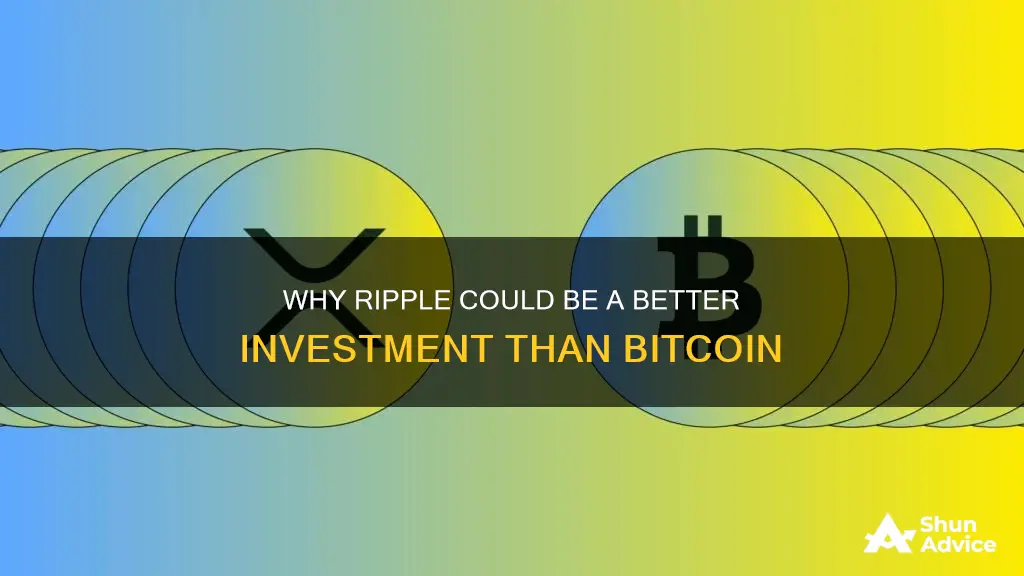
Bitcoin and Ripple are two of the most popular cryptocurrencies, but there are some clear differences between them. Bitcoin was the first cryptocurrency, created in 2009 by an anonymous developer called Satoshi Nakamoto. Ripple, on the other hand, was launched in 2012 by a company called Ripple Labs. Bitcoin is decentralised, peer-to-peer and controlled by its contributing community, whereas Ripple is owned and controlled by its parent company. Bitcoin is primarily used as a store of value and medium of exchange, while Ripple is a payment system used by banks for domestic and international transactions. Bitcoin's transaction fees are high compared to Ripple, which are practically free. Bitcoin also has a much lower supply than Ripple, with a maximum of 21 million coins compared to Ripple's 100 billion. So, which is the better investment? Well, that's hard to say. Both have their pros and cons, and the cryptocurrency market is notoriously volatile.
What You'll Learn

Bitcoin's blockchain vs. XRP's Federated Byzantine Agreement
Bitcoin's blockchain technology utilises a proof-of-work system, where network participants, or miners, validate transactions and solve complex cryptographic puzzles. This process is time-consuming and energy-intensive, resulting in high network fees and slow transaction and block creation times.
On the other hand, XRP, the native cryptocurrency of the XRP Ledger blockchain, employs a Federated Byzantine Agreement (FBA) consensus mechanism. In this system, each node is responsible for its own blockchain and can choose whom to trust. Quorums, or the minimum number of nodes required to validate a transaction, are formed dynamically through these trust choices. This allows for faster transaction processing times and lower fees compared to Bitcoin.
While Bitcoin's blockchain is decentralised and opposed to banks, XRP's FBA mechanism is more centralised. XRP was designed to serve as an intermediate currency for transactions between businesses and financial institutions, working directly with banks to implement its protocol.
In summary, Bitcoin's blockchain relies on a decentralised network of miners to validate transactions through computational power, resulting in slower and more expensive transactions. XRP's FBA mechanism, on the other hand, uses a more centralised approach, allowing for faster and cheaper transactions, making it a more scalable and flexible option.
The Evolution of Bitcoin: A Guide to Investing
You may want to see also

Bitcoin's transaction fees vs. XRP's low fees
Bitcoin transaction fees are a crucial component of the Bitcoin network, incentivising miners to process transactions efficiently and ensuring they are compensated for their work. The fees are based on the data volume of the transaction and user demand for block space. The more a user pays, the higher the chance their transaction will be picked up immediately. Transactions with higher fees are also prioritised to prevent clogging of the network.
Bitcoin transaction fees are entirely separate from the fees charged by exchanges and brokerages for buying and selling the cryptocurrency. The fees are also separate from Lightning Network fees, which are determined by the value of the transaction being sent along the network.
The average Bitcoin transaction fee is currently 1.089 USD/tx, up from 0.6237 the previous day and 0.8073 a year ago. This represents a change of 74.62% from the previous day and 34.91% from one year ago. Bitcoin transaction fees can spike during periods of congestion on the network, as they did during the 2017 Crypto boom, where they reached nearly 60 USD.
In contrast, XRP transactions do not have fees in the same way as Bitcoin. Instead, users are required to pay a small amount of XRP, which is burned by the network. The standard amount burned is 0.00001 XRP. XRP transactions are typically processed and confirmed within 3 to 5 seconds, while Bitcoin transactions can take anywhere from 10 minutes to several hours to confirm. The median fee for a Bitcoin transaction has been as high as $128.45 and was around $6 in May 2024.
The low fees of XRP transactions are due to the XRPL network's use of a social governance consensus mechanism, which consumes negligible amounts of energy. Participating nodes verify the authenticity of transactions by conducting polls, enabling near-instantaneous confirmations and cheaper transaction fees.
Calculating Your Bitcoin Investment's Average: A Simple Guide
You may want to see also

Bitcoin's scalability issues vs. XRP's high scalability
Bitcoin's scalability problem refers to the limited capability of the network to process transactions rapidly and efficiently. This is due to the average block creation time of 10 minutes and the original block size limit of 1 megabyte, which jointly constrain the network's throughput. As a result, users often face increased transaction fees and delayed processing times during peak periods. The Bitcoin blockchain can only process around 7 to 10 transactions per second (tps), far less than traditional payment systems like Visa, which can handle thousands of transactions per second.
To address this issue, several solutions have been proposed, including improved consensus mechanisms, implementing sharding, and utilising nested blockchains. However, finding a balance between decentralisation, security, and scalability remains a challenge, often referred to as the 'scalability trilemma'.
On the other hand, XRP, the native cryptocurrency of the XRP Ledger blockchain, is designed to be a faster and more scalable payment system. XRP is the only digital asset with a clear institutional use case: solving the global payment and liquidity challenges faced by banks, payment providers, and corporates. XRP's speed, transparency, and scalability enable financial institutions to move money in real time, just like information moves today.
The XRPL network employs a social governance consensus mechanism, the XRPL Consensus Protocol, which consumes negligible amounts of energy. Participating nodes verify the authenticity of transactions by conducting polls, enabling near-instantaneous confirmations, cheaper built-in transaction fees, and increased network scalability. XRP transactions are typically processed and confirmed within 3 to 5 seconds, while Bitcoin transactions can take anywhere from 10 minutes to several hours.
While Bitcoin's scalability issues have been well-documented, XRP offers a more scalable solution with faster transaction processing times and lower fees, making it a more attractive option for cross-border payments and other use cases requiring high throughput and efficiency.
Cash App Bitcoin Investing: A Beginner's Guide
You may want to see also

Bitcoin's mining vs. XRP's lack of mining
Bitcoin mining is a network-wide competition to generate a cryptographic solution that matches specific criteria. When a correct solution is reached, a reward in the form of bitcoin and fees for the work done is given to the miner(s) who reached the solution first. This reward process continues until 21 million bitcoins are in circulation. Once that number is reached, the Bitcoin reward is expected to cease, and Bitcoin miners will be rewarded through fees paid for the work done.
Miners have become very sophisticated over the years, using complex machinery and grouping to speed up mining operations. Bitcoin mining has also generated controversy because it is not considered environmentally friendly. The Bitcoin mining process consumes as much electricity as certain countries.
On the other hand, XRP, or Ripple, is a semi-centralised ledger intended to facilitate and speed up transactions. Unlike Bitcoin, it does not rely on mining to validate transactions. Instead, it uses a consensus ledger and a series of network servers to validate transactions. XRP is significantly faster and more flexible than the Bitcoin blockchain.
While Bitcoin mining is an energy-intensive process, XRP does not require mining in the same way. XRP was designed to serve as an intermediate currency for transactions covering multiple crypto-assets and networks between businesses. The only individuals who can mine XRP are those who created the asset. There are only 100 billion XRP coins, and every transaction eliminates the XRP coin used. As more people join in and start using the Ripple network, XRP coins will be gradually exhausted, or their value will rise.
Merrill Lynch's Bitcoin Investment Strategy: What You Need to Know
You may want to see also

Bitcoin's decentralisation vs. XRP's centralisation
Bitcoin is a decentralised cryptocurrency, meaning it operates without a central authority, like a government or bank, controlling it. Instead, it is run by a network of users who each have a copy of the blockchain. This makes it nearly impossible for a single entity to control the network or manipulate the currency.
Ripple, on the other hand, is a centralised cryptocurrency. The company Ripple owns 62% of all existing XRPs, giving it real centralisation. This has led to legal attacks that see the XRP token as a security.
Bitcoin's decentralisation is one of its key selling points. It was created in 2008 during the Great Recession and peak bank bailouts. Its creator, Satoshi Nakamoto, designed it to be the first peer-to-peer form of digital cash, allowing users to be their own bank and custody their own wealth without the need for a third party.
Ripple, however, works directly with banks to get them to implement the XRP protocol and replace cross-border payment solutions. While Ripple executives claim XRP is decentralised, critics argue that the distribution is too unfair for it to be considered so.
Bitcoin's decentralisation also means it is more resistant to censorship and gives it an anti-authoritarian character. This is in keeping with its origins as a response to the Great Recession.
However, some have argued that Bitcoin is not as decentralised as it seems. For example, the top five Bitcoin mining pools represent well over 50% of the total global hash rate. This gives them the power to corrupt Bitcoin and attempt double-spending.
In contrast, for Ripple to change the XRP ledger, it would require the collusion of many big-name companies, which is highly unlikely.
In summary, Bitcoin's decentralisation is a key feature that sets it apart from Ripple and other cryptocurrencies. It allows users greater freedom and control over their money, which is in keeping with Bitcoin's origins as a response to the Great Recession. However, some have argued that Bitcoin is not as decentralised as it seems, and the cryptocurrency may face increasing centralisation pressures as it becomes more widely adopted.
Blockchain Investment: Beyond Bitcoin and the Riot
You may want to see also
Frequently asked questions
Bitcoin was the first and original cryptocurrency, created in 2009. It was built by an anonymous developer called Satoshi Nakamoto, who wanted to create a new global payment system that would allow people to send and receive digital money on a peer-to-peer basis. Ripple, on the other hand, was first launched in 2012 and is the name of the blockchain technology that allows people to send and receive funds. XRP is the name of the cryptocurrency.
Ripple is faster, more scalable, and environmentally friendlier than Bitcoin. It is also cheaper, with transaction fees on Ripple being practically free.
Ripple has a lot of pros that many other cryptocurrencies do not have. It is intended to be used by major financial players and is getting adopted as such, meaning there is a lot of room for growth. However, investing in cryptocurrency is risky and it's important to do your own research before investing.







